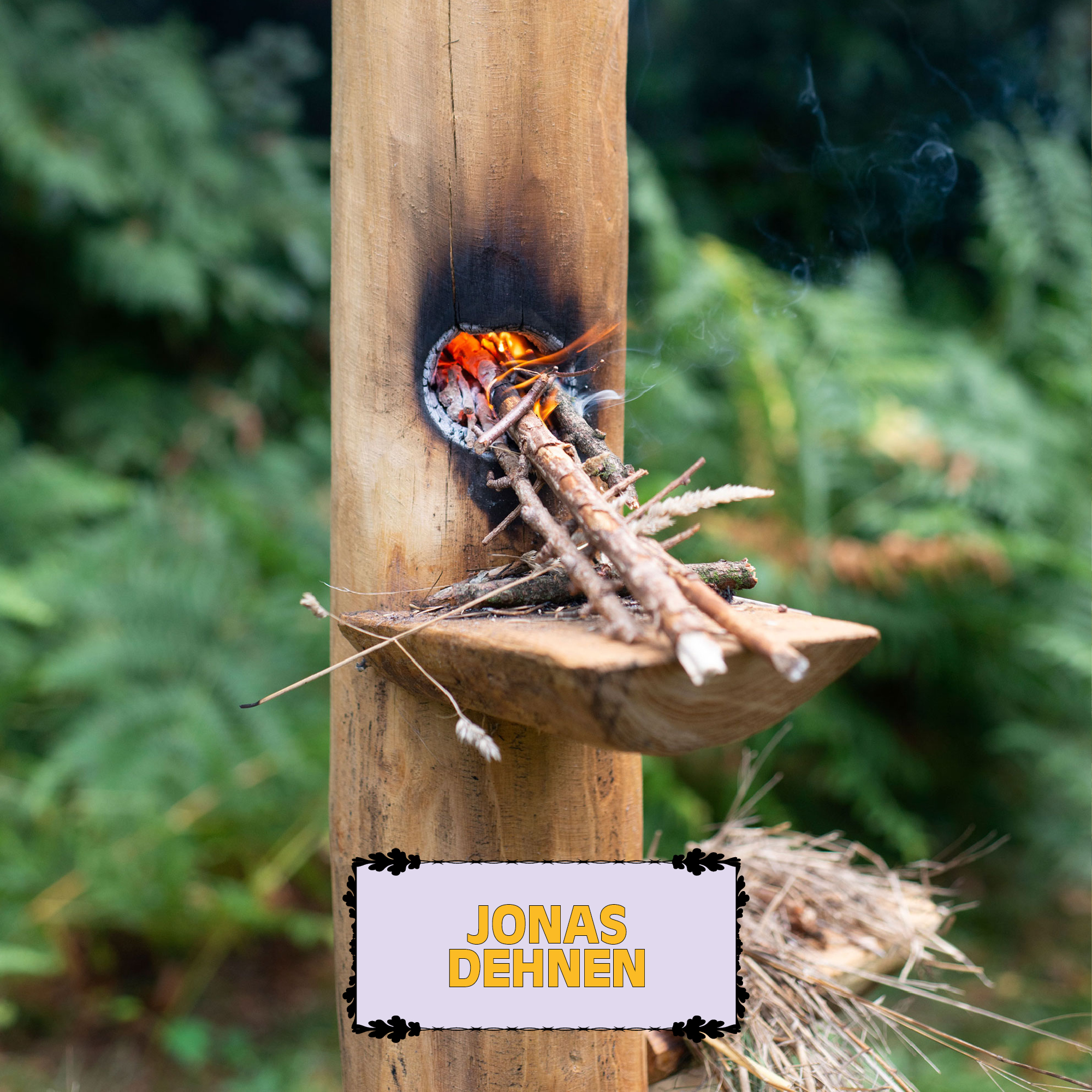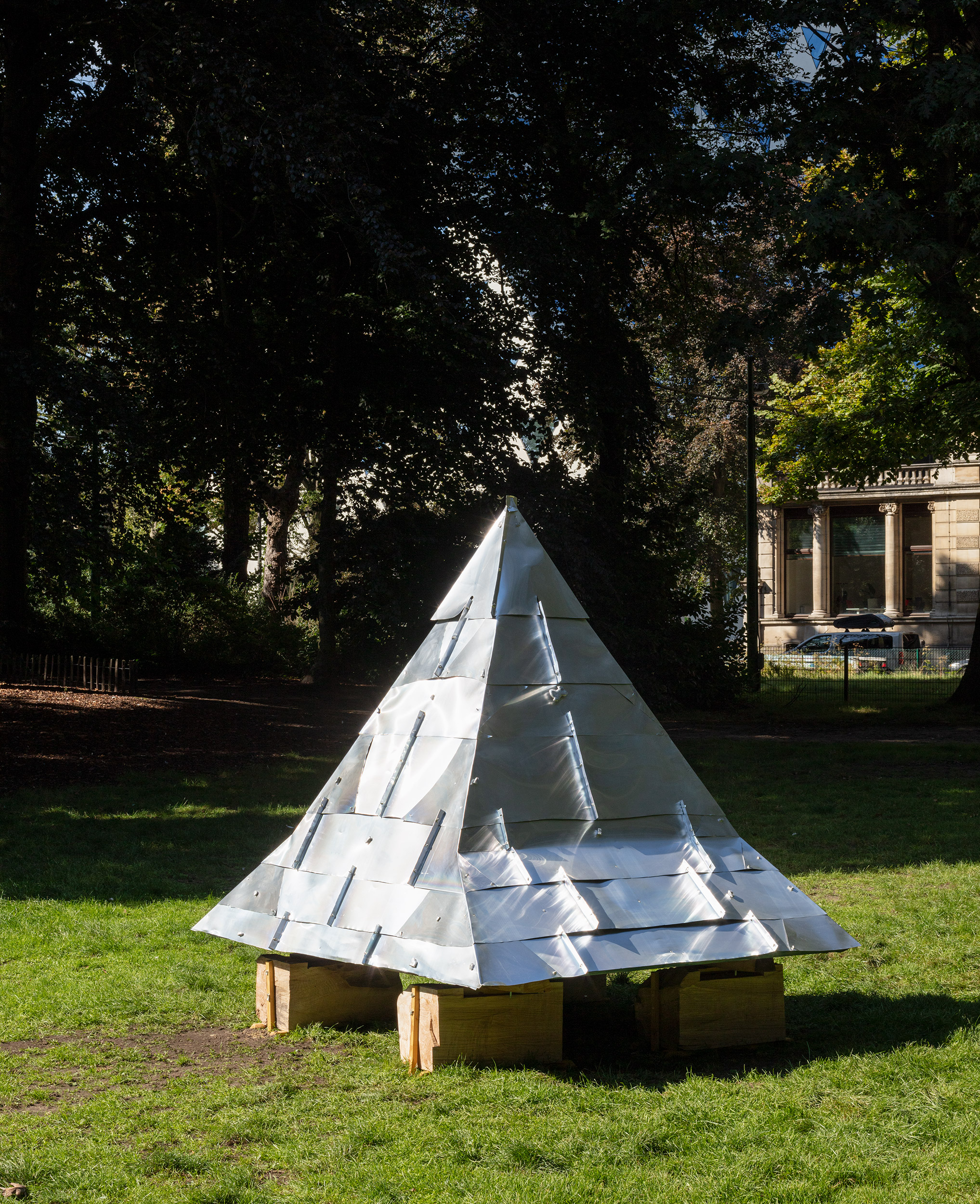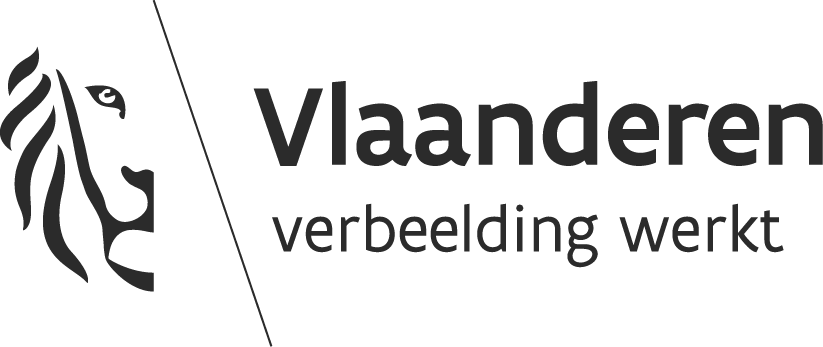Publiek Park 2023
![]()
Jonas Dehnen
Pterion shelter, oder die dünnste Stelle des Schädels, 2023

EN
Pterion shelter, oder die dünnste Stelle des Schädels, 2023
In his work, Jonas Dehnen plays with the genre of sculptural folly. A folly, in architecture, is a primarily decorative garden or park building, which through its appearance suggests a fictional purpose or history (for example a fake ruin or abandoned castle). Dehnen's work can be read as a tentative sculptural proposal for a park folly in the shape of a tin foil hat, a low-tech homemade protective device and a symbol of paranoia, superstition and conspiratorial beliefs. Furthermore, Dehnen's folly expands upon the visual language of the artist’s paintings and drawings, which for several years have integrated themes such as maps of French and English garden designs, or hermitages - an 18th and 19th-century trend in landscaping that can be situated in the wider cultural current of romanticism.
Jonas Dehnen’s (1992, DE/BE) practice is stubbornly devoted to traversing the jaded landscape of painterly tropes and conventions. To him, the medium of painting feels like treacherous ground, despite the fact that it’s long been charted. Dehnen interrogates the way in which contemporary paintings and art objects in general performatively parade their purported authenticity. Each work carefully follows its predecessors, in a slow and iterative picture-making process, in which visual themes grow and develop organically. This primarily plays out in paintings, drawings, and occasionally in three-dimensional work. Motifs drawn from literature intermingle with visual markers of identity. This might include pub signs, carnival floats, vernacular architecture, folk paintings and other elements of visual patois. These undergo a subjective examination led by the (im-)possibilities and the ‘cultural memory’ of the material and of matter itself.
The work of Jonas Dehnen is created within the framework of a collaboration between Publiek Park and Pizza Gallery, a contemporary art project space located in Borgerhout, Antwerp.
Pterion shelter, oder die dünnste Stelle des Schädels, 2023
In his work, Jonas Dehnen plays with the genre of sculptural folly. A folly, in architecture, is a primarily decorative garden or park building, which through its appearance suggests a fictional purpose or history (for example a fake ruin or abandoned castle). Dehnen's work can be read as a tentative sculptural proposal for a park folly in the shape of a tin foil hat, a low-tech homemade protective device and a symbol of paranoia, superstition and conspiratorial beliefs. Furthermore, Dehnen's folly expands upon the visual language of the artist’s paintings and drawings, which for several years have integrated themes such as maps of French and English garden designs, or hermitages - an 18th and 19th-century trend in landscaping that can be situated in the wider cultural current of romanticism.
Jonas Dehnen’s (1992, DE/BE) practice is stubbornly devoted to traversing the jaded landscape of painterly tropes and conventions. To him, the medium of painting feels like treacherous ground, despite the fact that it’s long been charted. Dehnen interrogates the way in which contemporary paintings and art objects in general performatively parade their purported authenticity. Each work carefully follows its predecessors, in a slow and iterative picture-making process, in which visual themes grow and develop organically. This primarily plays out in paintings, drawings, and occasionally in three-dimensional work. Motifs drawn from literature intermingle with visual markers of identity. This might include pub signs, carnival floats, vernacular architecture, folk paintings and other elements of visual patois. These undergo a subjective examination led by the (im-)possibilities and the ‘cultural memory’ of the material and of matter itself.
The work of Jonas Dehnen is created within the framework of a collaboration between Publiek Park and Pizza Gallery, a contemporary art project space located in Borgerhout, Antwerp.
NL
Pterion shelter, oder die dünnste Stelle des Schädels, 2023
In zijn werk speelt Jonas Dehnen met het genre van de sculpturale folly. Een folly, in de architectuur, is een voornamelijk decoratief tuin- of parkgebouw, dat door zijn verschijning een fictief motief of geschiedenis suggereert (bijvoorbeeld een nepruïne of verlaten kasteel). Het werk van Dehnen kan gelezen worden als een tentatief sculpturaal voorstel voor een parkfolly in de vorm van een aluminiumfoliehoed, een low-tech zelfgemaakt beschermingsmiddel en een symbool van paranoia, bijgeloof en complottheorie. Bovendien bouwt Dehnen's folly voort op de visuele taal van de schilderijen en tekeningen van de kunstenaar, die sinds enkele jaren thema's integreren zoals kaarten van Franse en Britse tuinontwerpen of kluizenaarsoorden - een 18e- en 19e-eeuwse trend in landschapsarchitectuur, gesitueerd in de bredere culturele stroming van de romantiek.
Jonas Dehnen (1992, DE/BE) wijdt zich aan het doorkruisen van het landschap van de schilderkunstige conventies. Het medium schilderkunst voelt voor hem aan als verraderlijk terrein, ondanks dat het al sinds lang in kaart is gebracht. Dehnen bevraagt de manier waarop hedendaagse schilderijen (en kunstobjecten in het algemeen) hun vermeende authenticiteit performatief tentoonstellen. Elk werk volgt zorgvuldig zijn voorgangers op in een langzaam proces van beeldcreatie, waarin visuele thema's organisch groeien en zich ontwikkelen. Zijn schilderijen, tekeningen en driedimensionale werken ontlenen hun motieven aan literatuur en vermengen deze met visuele tekens van identiteit. Deze omvatten onder meer uithangborden van cafés, carnavalswagens en volksarchitectuur tot volkskunst en andere vormen van visueel patois. Ze worden onderworpen aan een subjectieve verkenning, gestuurd door de (on-)mogelijkheden en het 'culturele geheugen' van het materiaal en de materie zelf.
Het werk van Jonas Dehnen kwam tot stand in het kader van een samenwerking tussen Publiek Park en Pizza Gallery, een hedendaagse kunstgalerie gevestigd in Borgerhout, Antwerpen.
Pterion shelter, oder die dünnste Stelle des Schädels, 2023
In zijn werk speelt Jonas Dehnen met het genre van de sculpturale folly. Een folly, in de architectuur, is een voornamelijk decoratief tuin- of parkgebouw, dat door zijn verschijning een fictief motief of geschiedenis suggereert (bijvoorbeeld een nepruïne of verlaten kasteel). Het werk van Dehnen kan gelezen worden als een tentatief sculpturaal voorstel voor een parkfolly in de vorm van een aluminiumfoliehoed, een low-tech zelfgemaakt beschermingsmiddel en een symbool van paranoia, bijgeloof en complottheorie. Bovendien bouwt Dehnen's folly voort op de visuele taal van de schilderijen en tekeningen van de kunstenaar, die sinds enkele jaren thema's integreren zoals kaarten van Franse en Britse tuinontwerpen of kluizenaarsoorden - een 18e- en 19e-eeuwse trend in landschapsarchitectuur, gesitueerd in de bredere culturele stroming van de romantiek.
Jonas Dehnen (1992, DE/BE) wijdt zich aan het doorkruisen van het landschap van de schilderkunstige conventies. Het medium schilderkunst voelt voor hem aan als verraderlijk terrein, ondanks dat het al sinds lang in kaart is gebracht. Dehnen bevraagt de manier waarop hedendaagse schilderijen (en kunstobjecten in het algemeen) hun vermeende authenticiteit performatief tentoonstellen. Elk werk volgt zorgvuldig zijn voorgangers op in een langzaam proces van beeldcreatie, waarin visuele thema's organisch groeien en zich ontwikkelen. Zijn schilderijen, tekeningen en driedimensionale werken ontlenen hun motieven aan literatuur en vermengen deze met visuele tekens van identiteit. Deze omvatten onder meer uithangborden van cafés, carnavalswagens en volksarchitectuur tot volkskunst en andere vormen van visueel patois. Ze worden onderworpen aan een subjectieve verkenning, gestuurd door de (on-)mogelijkheden en het 'culturele geheugen' van het materiaal en de materie zelf.
Het werk van Jonas Dehnen kwam tot stand in het kader van een samenwerking tussen Publiek Park en Pizza Gallery, een hedendaagse kunstgalerie gevestigd in Borgerhout, Antwerpen.




Photos by Michiel De Cleene & Charley Croonen

